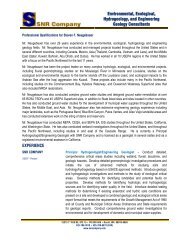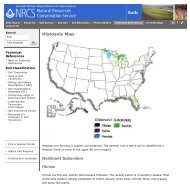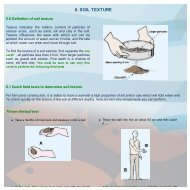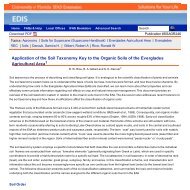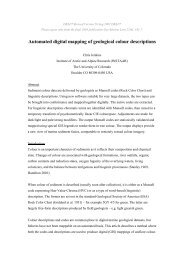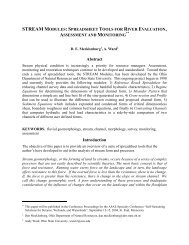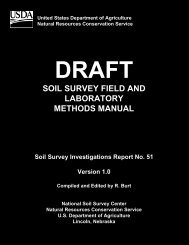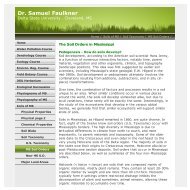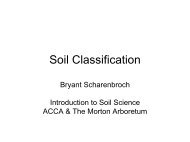chapter 3 fundamentals of fluvial geomorphology and stream ...
chapter 3 fundamentals of fluvial geomorphology and stream ...
chapter 3 fundamentals of fluvial geomorphology and stream ...
You also want an ePaper? Increase the reach of your titles
YUMPU automatically turns print PDFs into web optimized ePapers that Google loves.
3.7.4.2 Up<strong>stream</strong> FactorsThe stability <strong>of</strong> a <strong>fluvial</strong> system can also be significantlyaffected by changes to up<strong>stream</strong> reaches that alter thedown<strong>stream</strong> discharge or sediment supply. The flow regime <strong>and</strong>sediment load together, constitute the two main driving variablesresponsible for forming <strong>and</strong> maintaining the <strong>stream</strong> <strong>and</strong> it is nosurprise that the stability <strong>of</strong> an alluvial river may well be disturbedby changes in one or both <strong>of</strong> these factors. Up<strong>stream</strong> factors are<strong>of</strong>ten affected by engineering <strong>and</strong> river-management projects <strong>and</strong>the case <strong>of</strong> river regulation by a dam or diversion structure is acommon cause <strong>of</strong> down<strong>stream</strong> channel adjustment that serves toillustrate the types <strong>and</strong> complexity <strong>of</strong> system response that mayresult from such changes.Channel response down<strong>stream</strong> <strong>of</strong> a dam or diversionstructure depends on the way the works are constructed <strong>and</strong>operated. When the structure is built, sediment supplydown<strong>stream</strong> may be elevated due to disruption <strong>of</strong> the channel <strong>and</strong>floodplain during construction. This may increase supply overtransport capacity, inducing an initial adjustment throughaggradation. However, this response will be absent if appropriatesediment control measures are applied on site. Once the works arecomplete, process-response down<strong>stream</strong> will depend on thebalance <strong>of</strong> changes to the water <strong>and</strong> sediment regimes. Followingclosure <strong>of</strong> the dam or diversion, sediment is trapped in the poolup<strong>stream</strong> <strong>of</strong> the structure. Sediment-free water released from thestructure then scours the bed down<strong>stream</strong>, generating degradationin the first few kilometers below the dam. Initially, the flush <strong>of</strong>sediment produced drives aggradation further down<strong>stream</strong>, but asthe <strong>stream</strong> slope immediately down<strong>stream</strong> <strong>of</strong> the dam flattens,sediment output decreases <strong>and</strong> the leading edge <strong>of</strong> the zone <strong>of</strong>degradation migrates down<strong>stream</strong> to re-erode recently depositedsediment <strong>and</strong> sends it further down<strong>stream</strong>, as an aggradationalwave. This conceptual model <strong>of</strong> river response to closure <strong>of</strong> a damhas been observed in many rivers, <strong>and</strong> yet this pattern <strong>of</strong>adjustment is by no means universal. To explain why, it isnecessary to consider the other morphological responses that maydominate adjustment <strong>of</strong> the <strong>fluvial</strong> system. For example, if the beddown<strong>stream</strong> <strong>of</strong> the dam includes a widely graded, coarse-grainedfraction, bed armoring may limit degradation <strong>and</strong> stabilize the bedat a steeper slope than that prior to dam construction. The sameeffect may result from the presence <strong>of</strong> a geological control, whilewidening with limited reduction in bed level may be triggered if the<strong>stream</strong> banks down<strong>stream</strong> <strong>of</strong> the dam are close to the criticalheight for mass instability (Thorne <strong>and</strong> Osman 1988). If regulationby the dam significantly reduces the magnitude or frequency <strong>of</strong>sediment transporting flows, degradation may be limited ornegligible, <strong>and</strong> if a reduction in the competence <strong>of</strong> the main <strong>stream</strong>is coupled with the input <strong>of</strong> a substantial sediment load fromunregulated tributaries, aggradation may occur down<strong>stream</strong> <strong>of</strong> theFundamentals <strong>of</strong> Fluvial Geomorphology <strong>and</strong> Stream Processes 53



